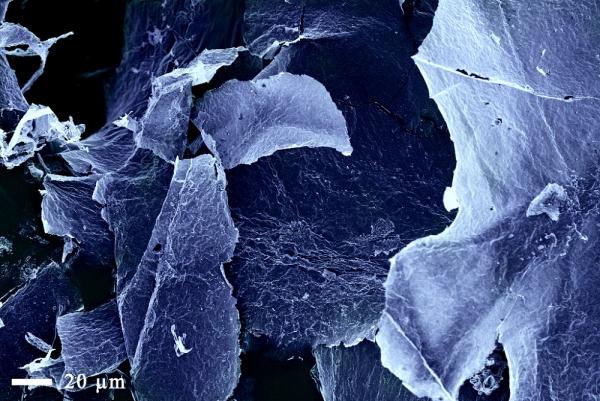MXenes - a new family of 2D materials at the Warsaw University of Technology
MXene phases are a young group of two-dimensional (2D) nanomaterials with intermediate properties between metals and ceramics, explored to a limited extent so far. Since their appearance, comprehensive research is carried out at the Warsaw University of Technology.
Since the discovery of the specific properties of graphene, there has been a large increase in interest in 2D materials. Progress in the field of technical sciences creates many opportunities for the development of such materials and it can now be considered one of the fastest developing fields in nanoscience. New structures are interesting in this area because of their specific physico-chemical and bioactive properties. Such exciting materials are MXenes phases, also known as light transition metal carbides, nitrides and carbonitrides. The first reports about them date back to 2011, when a research group from Drexel University, USA, published their first pioneering work in the Advanced Materials journal. Like most groundbreaking discoveries in science, the idea of their targeted etching by the method of selective elimination of one of the elements and delamination into single flakes appeared unexpectedly during research on porous electrode materials for use in supercapacitors. In a short time, it turned out that this is a very large group of a new type of materials with anisotropic crystal structure, showing long-range ordering due to the presence of strong chemical bonds. The first effects of research on MXenes were structures such as Ti2C, Ti2N, Nb2C, V2C, Mo2C, Ti3C2, Ti2CN, Ti4N3, or Nb4C3. They are written with 'Mn+1Xn' notation, which reflects their stoichiometric system, where: M is a light transition metal, X - carbon and/or nitrogen, and n = 1, 2 or 3. In MXene phases, there is a layered M-X arrangement, thanks to which they are characterized by charming harmony-like morphology. Below there is an exemplary SEM image of the most popular Ti3C2 MXene phase (see photo 1). The same material after delamination has a morphology reduced to individual flakes, very similar to popular graphene or graphene oxide (see photo 2).
MXene phases are still a young member of the exciting group of 2D materials. Since the appearance of MXenes at the Warsaw University of Technology, research has been carried out extensively, led by dr Agnieszka Jastrzębska from the WUT Faculty of Materials Science and Engineering. The research is conducted in wide cooperation of four WUT faculties, i.e., Faculty of Materials Science and Engineering, Faculty of Chemistry, Faculty of Building Services, Hydro and Environmental Engineering, as well as the Faculty of Physics. Recently, other scientific units joined this undertaking, such as AGH University of Science and Technology in Krakow, University of Warsaw, Adam Mickiewicz University in Poznań, and units located in Szczecin, i.e., West Pomeranian University of Technology and Pomeranian Medical University.
International cooperation of the Polish research group from the Faculty of Materials Science and Engineering within the framework of MXenes includes pioneering units from the US: Drexel University and Tulane University, Universitatea Tehnica Cluj-Napoca (Romania), and Palacký University Olomouc (Czech Republic).
The main purpose of the joint research work is to examine biocidal properties of MXenes, photocatalytic efficiency, strengthening properties in ceramic matrix composites, as well as anticancer, cytotoxic and ecotoxic properties of these new 2D materials. The intermediate objectives relate to the implementation of dedicated methods for the synthesis of starting materials (MAX phases), effective methods of delamination into 2D flakes, development of surface-modification methods, also based on a combination of experimental research with computer simulations.
The joint research work carried out so far and the development prospects for MXenes have resulted in the first financial support from national agencies, including projects financed by the National Science Centre (NCN) and the Ministry of Science and Higher Education (MNiSW). The Faculty of Materials Science and Engineering of the Warsaw University of Technology in a consortium with the Faculty of Physics of the University of Warsaw carries out the Sonata Bis 7 (NCN) project entitled ‘Research on the anti-cancer properties of 2D nano-crystals of carbide and titanium nitrides - MXenes phases’. The mentioned projects are led by dr Agnieszka Jastrzębska, like the Iuventus Plus (MNiSW) project concerning ‘Research on the bio-active properties of new two-dimensional light transition metal carbide structures’. Professor Andrzej Olszyna manages the Opus 13 (NCN) project entitled ‘Research on the properties of composites with a new family of 2D crystals’. Recently, the Polish MXenes team has also received support under the Opus 16 (NCN) project ‘The new generation of nanostructures and devices based on two-dimensional materials MXenes’, under the leadership of Professor Jacek Majewski from the Faculty of Physics, University of Warsaw. The WUT Faculty of Materials Science and Engineering is a consortium member of this project.
It should be noted that it is also very important to search for suitable applications for the developed MXenes materials and to select candidate structures with the highest application potential. Such works are still in the trial and testing phase, but given the effective cooperation of the teams involved, promising results are to be expected soon.
Summing up the research work carried out on MXene phases at the Warsaw University of Technology, one can notice their wide scope and diverse features. Actions also include a number of other types of activities aimed at creating appropriate dedicated research facilities and an interdisciplinary team of experts focused around the WUT Faculty of Materials Science and Engineering, specializing in the production and characterization of MXenes phases. The involved scientists hope for practical applications of the developed materials in the industry. This will be possible due to efficient coordination of work and, above all, strategic support for the planned research and R&D projects that the Polish MXenes group will apply for.
More information about the research on MXenes, carried out at the Warsaw University of Technology is available here »


